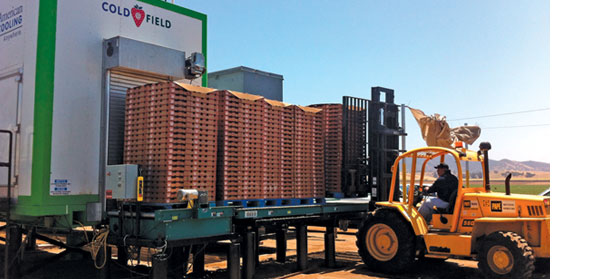
Aug 15, 2012System cools strawberries in field for longer shelf life
Freshly picked strawberries can spend hours in hot fields, waiting to be taken in for packing and processing. Long exposure to heat can reduce shelf life and profits for growers – a problem Naturipe Berry Growers in Salinas, Calif., is trying to solve with its new Cold@Field in-field cooling systems.
Growers have long known that quickly removing the field heat from a harvested strawberry is crucial to preserving its freshness and quality. Using the Cold@Field system, the strawberries are cooled to 32˚ F in self-contained, portable berry cooling plants, which are placed at the entrance to the grower’s field. This results in extended shelf life of strawberries by up to two days, said Rich Amirsehhi, CEO of Naturipe.
“In 2010, we conducted several research projects to address the areas where we could positively impact strawberry quality, condition, shelf life and, most importantly, the taste and eating experience,” Amirsehhi said. “In collaboration with American Cooling, we took a different approach to berry cooling and developed new technologies for strawberry cooling that can start as soon as 30 minutes after harvest.”
There are benefits for shipping strawberries as well, he said. A trailer can pull right up to the temperature-controlled loading dock. This eliminates storage time, reduces handling and temperature variations and speeds up loading.
Jim Thompson, a former professor of post-harvest engineering with the University of California who now works for Postharvest Engineering, assisted the Naturipe team. He said moisture loss is the best reason to cool strawberries in the field.
“For every 20˚ F drop in temperature, the moisture loss is cut in half and the respiration rate is reduced by a factor of two to three,” Thompson said. “Those are very significant numbers; the faster you shut down moisture loss and respiration, the sooner shriveling and metabolism slow down, meaning less loss of the sugars and acids that give strawberries their unique flavor.”
Amirsehhi said the added expense is worth it.
“We are taking proactive measures at all levels of our organization to focus on delivering great-tasting berries,” Amirsehhi said. “Our goal is to increase the speed to market, reduce shrink throughout the supply chain and improve the taste, giving consumers more time to enjoy our strawberries.”
Florida berries
California growers are not the only ones using in-field cooling systems. Wish Farms in Plant City, Fla., has been using mobile cooling trailers for 10 year, said Gary Wishnatzki, Wish Farms’ CEO.
“We move them around season to season depending on where we need them,” he said. “We even lease the units out when we’re not using them, if someone else needs them.”
The units Wish Farms uses are not like normal refrigerated trailers, Wishnatzki said. Instead of having air that circulated from one end. The units Wish Farms uses have air that circulates from the sides, making for evenly cooled berries.
— Derrek Sigler
none
















